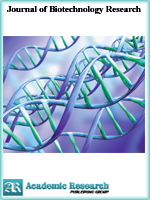Journal of Biotechnology Research
Online ISSN: 2413-3256
Print ISSN: 2413-8878
Print ISSN: 2413-8878
Quarterly Published (4 Issues Per Year)

Archives
Volume 5 Number 2 February 2019
Microbiological Quality Assessment of Commercially and Laboratory Prepared Orange Juice
Authors: Obasi B. C. ; Whong C. M. Z. ; Ameh J. B. ; Ella E. E.
Pages: 19-27
DOI: doi.org/10.32861/jbr.52.19.27
Abstract
Orange juice has become one of the most widely accepted natural beverages due to its invigorating flavours, source of quick energy in the form of natural sugars and its nutrient which support the growth of acid tolerant bacteria, yeasts and moulds. Present investigation was conducted to study the microbiological examination of commercially and freshly prepared orange juices. Freshly prepared orange juices were pasteurised, carbonated, concentrated and chemically treated with a preservative (sodium metabisulphite) and stored under, freezer, refrigeration and ambient temperature for 90 days. The pH ranged from 3.0 to 4.5 for the commercially, fresh and stored samples respectively. The total bacterial load ranged from 1.6x105 to 3.6x106 and the total yeast cell counts ranged from 1.7x104 to 4.8x106 cfu/ml for the commercially, freshly and stored samples. Twenty-two microbial species including 5 bacterial isolates, 6 yeast isolates and 11 isolates of mould were isolated from the orange juices. The bacterial isolates identified from the samples were Bacillus megaterium, Bacillus cereus, Bacillus pantothenticus, Bacillus aeruginosa and Escherichia coli. The fungal isolates were Saccharomyces cerevisiae, Saccharomyces rouxii, Saccharomyces telluris, Blastomyces sp, Aspergillus sp, Mycelia sp, Chrysosporium sp, and Trichoderma sp. Among the bacterial isolates, Bacillus sp was the predominant, while the fungi Saccharomyces sp and Mycelia sp were the predominant fungi and accounted for five out of 11 isolates. The isolates of bacteria, yeasts and moulds appear to be persistent throughout the period of this study and could be used as indicators of microbial quality. A safe microbial load and reduction in contamination of orange juice /fruit juices can be achieved by combination of processing methods such as chemical preservatives with pasteurisation,concentration with carbonation under controlled microbiological environments such as freezer and refrigeration temperatures.



